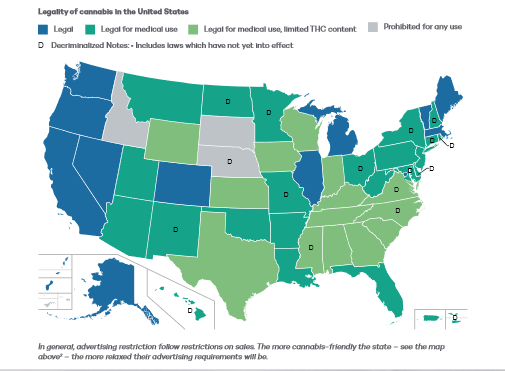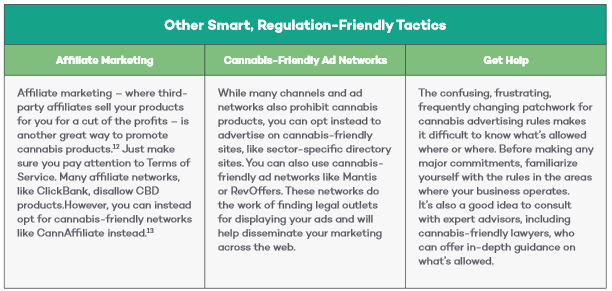CANNABIS COMPANIES OCCUPY A FRAUGHT POSITION WHEN IT COMES TO MARKETING AND ADVERTISING THEIR PRODUCTS.
There’s a huge potential audience for cannabisrelated products in the United States: around 40% of U.S. consumers 21 or older indicate some interest in CBD.1 Advertising and marketing are how companies find this audience and turn interested parties into paying customers.
Marketing is also crucial to carving out market share, building a brand, and differentiating your company from your competitors.
However, unfortunately, marijuana is categorized as a Class I drug under the federal Controlled Substances Act (CSA). That puts it in the same group as substances like cocaine and heroin. Under the terms of the CSA, it is illegal to advertise for the sale of cannabis products on the federal level, so many platforms and organizations (like Google) that operate nationwide also disallow advertising for cannabis products.
Yet many states and municipalities do allow the sale of cannabis products, though some restrict it to medical products, some restrict THC content, and only a few states have outright decriminalized it. Worse, many of these laws do not differentiate between CBD- or THC- containing products (e.g., edibles) specifically and the various supplies or equipment required to produce or use them.
The 2015 Rohrabacher-Farr Amendment prohibits the Department of Justice from preventing individual states from implementing their own legalized medical marijuana laws. However, that amendment has strict limits: it focuses on medical marijuana and, because it was attached to a budget bill, must be renewed annually.
All of this creates an enormous amount of confusion and difficulty when it comes to getting the word out about weed.
What do companies operating in the cannabis sector need to know about the laws affecting their marketing activities, and what are the best online marketing tactics to build business without running afoul of this confusing minefield of restrictions and regulations?
That’s what this paper will address
In This Paper...
- General advertising restrictions
- Advertising on platforms
- SEO
- Content Marketing
- Review Management
- Other Tactics
Where is cannabis legal?

Advertising and marketing for cannabis products is a minefield – and one that’s incredibly complicated.
Cannabis advertising is outright banned in some cases, subject to strict requirements in others, and in all cases, the legalities depend entirely the state and municipality in which your business is operating. Worse, penalties – which vary enormously by state – can be steep, including major fines and even jail time for violations. We detail some of the most common and widespread restrictions and guidelines below.
Don’t advertise where minors can see.
Many states prohibit advertising anywhere a significant portion of the audience can be “reasonably expected” (a frustratingly imprecise criteria) to be under the age of 21.3 In California, no more than 28.4% of the audience can be under 21. In Colorado, it’s 30%.4 Washington state does not allow cannabis advertising within 1,000 feet of schools, playgrounds, childcare facilities, etc.
Don’t advertise through TV, radio, or mail.
Those channels are governed by federal law, which makes anything cannabis-related – even products and supplies just related to cannabis, but which don’t contain any CBD or THC themselves – a non-starter. Alternative options might include online radio and private podcasts.
Distinguish between medical and recreational.
Medical marijuana marketing should avoid suggesting cannabis intended for medical use will have any recreational value. On the flip side, recreational marijuana users should avoid suggesting their products have any medical or therapeutic value. Some places, like Minnesota, restrict advertisements from showcasing cannabis products and paraphernalia directly. In these cases, you may focuses advertising more on the business and less on the products.
Meet all standard guidelines for advertising.
In addition to its other restrictions, cannabis advertising remains subject to the same guidelines and requirements as any other product. That means marketing and advertising must be truthful and evidence-based, according to the Federal Trade Commission (FTC).5 As a result, advertisements should try to avoid making false safety claims or showcasing unproven therapeutic benefits. Further, some places may require companies to list possible side effects. Please consult an attorney in your area for more information about the specific rules that affect your business.
What about advertising on platforms like Google and Facebook?
In general, most major technology and social media platforms follow federal guidelines when it comes to advertising requirements and restrictions. Unfortunately, that means almost all of them impose limits on how, when, where – and even if – cannabis-related products can be sold or advertised.
.png)
The top advertising and marketing tactics when faced with regulatory constraints.
Search Engine Optimization (SEO)
For the most part, the laws and regulations that restrict active advertising do not apply to search indexing. Search engines like Google will still index and rank your website in response to appropriate search terms.
And this is good news: 93% of online experiences start with a search engine.6
As a result, from a marketing and advertising perspective, SEO is an excellent way to generate visibility for your business without violating advertising laws.
That said, there’s an important caveat to keep in mind: Watch the keywords you use.
This is probably the one area of concern with SEO for cannabis-related companies. If your business draws attention from any federal entity, like the U.S. Food and Drug Administration (FDA) or the Federal Trade Commission (FTC), and they start investigating your advertising, they can look at the specific keywords you use. This refers to the words and phrases you have targeted to show up for specific searches.
If the keywords you choose might fall afoul of restrictions on false advertising or promoting unproven claims, your business can still find itself in trouble.
One way to deal with this is to emphasize both demand generation and demand capture. The latter means getting your business in front of people who are already looking for cannabis and cannabis -related products by searching for phrases like “Best THC gummies” or “Best CBD products for anxiety.” Demand generation means getting in front of people not actively looking for what you’re selling. For example, you might try to rank for searches around “how to reduce anxiety.” Your content can include CBD products as a way to do so – just don’t oversell or include unproven claims!
Content Marketing
One of the foundational pillars of any SEO program is content. Google’s search ranking algorithm is complex, but fundamentally it wants to offer its users the exact kind of websites they want. How does it know? It reads (“indexes”) your content.
Beyond that, from an advertising perspective, content is an extremely effective way to develop your brand and find potential consumers without running afoul of advertising laws. You can publish blog posts, articles, and informational guides; offer webinars and video tutorials; create newsletters; and more – all of which can help spread awareness of your brand and generate more interest in your products.
Indeed, educational and informational material is particularly powerful for operators in the cannabis space.
First, it’s easier to comply with advertising laws if you produce well-researched materials that are less about making sales claims and more about helping the reader to understand what your products are, what they do, what they don’t do, and what the research says about them.
Second, content is an excellent way to overcome the misperceptions and misinformation around marijuana use – both medical and recreational. “Unfortunately, the majority of information circulating in the popular media about cannabis is misinformation,” says Carey Clark, director of nursing and the chair of the Medical Cannabis Certificate Program at Pacific College of Health and Science.7
Because of the confused status of marijuana under federal and state laws, many consumers have no idea what’s legal or not legal, what’s true or not true, what cannabis can and cannot do. This places a burden on cannabis sector companies to educate their customer base and overcome any biases or objections. Content is the perfect way to do that.
Reviews let your customers do your selling for you; review management ensures their words work in your favor.
One of the absolute best ways to market yourself in a highly restricted advertising environment: let others do it for you. User-generated content – including testimonials, reviews, and social media content – that your customers and others create on your behalf is extremely powerful. People trust user reviews 12 times more than corporate content anyways, so this kind of content is more impactful on potential customers anyways.8 Even better, reviews are a great way to both develop new leads and boost conversion rates. As a result, review management is a high ROI activity that does not require the company to actually sell itself.
However, tread carefully. An investigation by The Los Angeles Times found nearly two-thirds of reviews on directory site weed maps were fake.9
It’s one thing when reviews represent the honest opinions of customers; it’s another when the reviews skirt the boundaries of false advertising laws. If nothing else, if discovered, the situation can ruin a company’s reputation. Worse, if the offense is serious enough, it might even draw the attention of federal regulators. As the FTC says, “It’s unwise to incentivize positive skewed reviews.”10
Indeed, The Los Angeles Times also found that many reviews had been incentivized via discount or free products. This is a different situation; incentivized reviews are not necessarily inauthentic or less trustworthy, but it also depends on the service’s Terms of Service. Google, for example, explicitly says, “Don’t offer or accept money, products, or services to write reviews for a business or to write negative reviews about a competitor.”11

Refrences
1 https://www.highyieldinsights.com/
2 Map by Lokal_Profil, https://commons.wikimedia.org/wiki/File:Map_of_US_state_cannabis_laws.svg
3 https://leginfo.legislature.ca.gov/faces/codes_displayText. xhtml?lawCode=BPC&division=10.&title=&part=&chapter=15.&article=
4 https://www.marijuanadoctors.com/online-guides/guide-to-advertising-on-marijuana-doctors/chapter-2- marijuana-advertising-laws-and-regulations/
5 https://www.ftc.gov/tips-advice/business-center/advertising-and-marketing
6 https://www.searchenginejournal.com/10-stats-to-justify-seo/36762/
7 https://www.forbes.com/sites/petersuciu/2020/02/07/cannabis-misinformation-spreading-on-socialmedia/#1c0535ba2345
8 https://www.emarketer.com/Article/Role-of-Customer-Product-Reviews/1008019
9 https://www.medicaljane.com/2016/09/10/buyer-beware-what-you-need-to-know-about-weed-locatorservices-like-weedmaps-and-leafly/
10 https://www.ftc.gov/news-events/blogs/business-blog/2019/04/its-unwise-incentivize-positive-skewedreviews
11 https://www.forbes.com/sites/steveolenski/2016/06/27/the-danger-of-incentivizing-customerreviews/#557f2657def6
12 https://support.clickbank.com/hc/en-us/articles/220364507-Selling-Physical-Pro
13 https://cannaffiliate.com/


